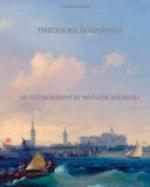Under this flank fire it soon became impossible to continue the march. The first brigade halted, deployed, and finally began to fire back. Then our brigade was halted. From time to time some of our men would fall, and I sent repeated word to the rear to try to get authority to attack the hills in front. Finally General Sumner, who was fighting the division in fine shape, sent word to advance. The word was brought to me by Mills, who said that my orders were to support the regulars in the assault on the hills, and that my objective would be the red-tiled ranch-house in front, on a hill which we afterwards christened Kettle Hill. I mention Mills saying this because it was exactly the kind of definite order the giving of which does so much to insure success in a fight, as it prevents all obscurity as to what is to be done. The order to attack did not reach the first brigade until after we ourselves reached it, so that at first there was doubt on the part of their officers whether they were at liberty to join in the advance.
I had not enjoyed the Guasimas fight at all, because I had been so uncertain as to what I ought to do. But the San Juan fight was entirely different. The Spaniards had a hard position to attack, it is true, but we could see them, and I knew exactly how to proceed. I kept on horseback, merely because I found it difficult to convey orders along the line, as the men were lying down; and it is always hard to get men to start when they cannot see whether their comrades are also going. So I rode up and down the lines, keeping them straightened out, and gradually worked through line after line until I found myself at the head of the regiment. By the time I had reached the lines of the regulars of the first brigade I had come to the conclusion that it was silly to stay in the valley firing at the hills, because that was really where we were most exposed, and that the thing to do was to try to rush the intrenchments. Where I struck the regulars there was no one of superior rank to mine, and after asking why they did not charge, and being answered that they had no orders, I said I would give the order. There was naturally a little reluctance shown by the elderly officer in command to accept my order, so I said, “Then let my men through, sir,” and I marched through, followed by my grinning men. The younger officers and the enlisted men of the regulars jumped up and joined us. I waved my hat, and we went up the hill with a rush. Having taken it, we looked across at the Spaniards in the trenches under the San Juan blockhouse to our left, which Hawkins’s brigade was assaulting. I ordered our men to open fire on the Spaniards in the trenches.




